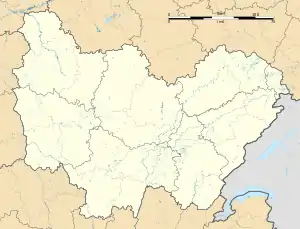Poligny, Jura
Poligny is a commune in the Jura department in Bourgogne-Franche-Comté in eastern France.
Poligny | |
|---|---|
 A general view of Poligny | |
.svg.png.webp) Coat of arms | |
Location of Poligny 
| |
 Poligny  Poligny | |
| Coordinates: 46°50′12″N 5°42′31″E | |
| Country | France |
| Region | Bourgogne-Franche-Comté |
| Department | Jura |
| Arrondissement | Dole |
| Canton | Poligny |
| Intercommunality | Communauté des communes, Arbois, Poligny, Salins - Coeur du Jura |
| Government | |
| • Mayor (2014–2020) | Dominique Bonnet |
| Area 1 | 50.22 km2 (19.39 sq mi) |
| Population (2017-01-01)[1] | 4,047 |
| • Density | 81/km2 (210/sq mi) |
| Time zone | UTC+01:00 (CET) |
| • Summer (DST) | UTC+02:00 (CEST) |
| INSEE/Postal code | 39434 /39800 |
| Elevation | 252–626 m (827–2,054 ft) |
| 1 French Land Register data, which excludes lakes, ponds, glaciers > 1 km2 (0.386 sq mi or 247 acres) and river estuaries. | |
The town stands at the foot of the first plateau of the Jura region, with limestone cliffs rising to its east and south, and a steephead valley leading to the village of Vaux-sur-Poligny to the east. On the cliffs to the east is a notable cave, known as "Le Trou de la Lune" (the Moonhole); on the cliffs to the south is a large cross, the "Croix du Dan". A network of hiking trails surrounds the town and provide routes to both these viewpoints, and the GR 59 long distance footpath runs through the town.
First Empire general Jean-Pierre Travot was born in Poligny; a statue in his honour stands in the principal square of the town, the Place des Déportés, and a road is named after him.
Poligny is served by the railway line from Besançon to Lons-le-Saunier.
The town is recognised as the "Capital of Comté", with a third of the region's production of this much-loved cheese being aged in the town's cellars. The town is also surrounded by vineyards, and is home to a number of independent wine producers as well as a cooperative.
Population
|
|
Gallery
 Croix du Dan
Croix du Dan
_Church.jpg.webp) Collégiale St.Hippolyte
Collégiale St.Hippolyte Convent des Ursulines
Convent des Ursulines Mouthier le Vieillard
Mouthier le Vieillard Wladimir Gagneur
Wladimir Gagneur Tower of Paravis
Tower of Paravis Tower of the "Sergenterie"
Tower of the "Sergenterie"
_Trou_de_la_Lune.jpg.webp) Le Moon hole
Le Moon hole La "Roche Percée"
La "Roche Percée"
See also
External links
| Wikimedia Commons has media related to Poligny (Jura). |
- . Encyclopædia Britannica (11th ed.). 1911.